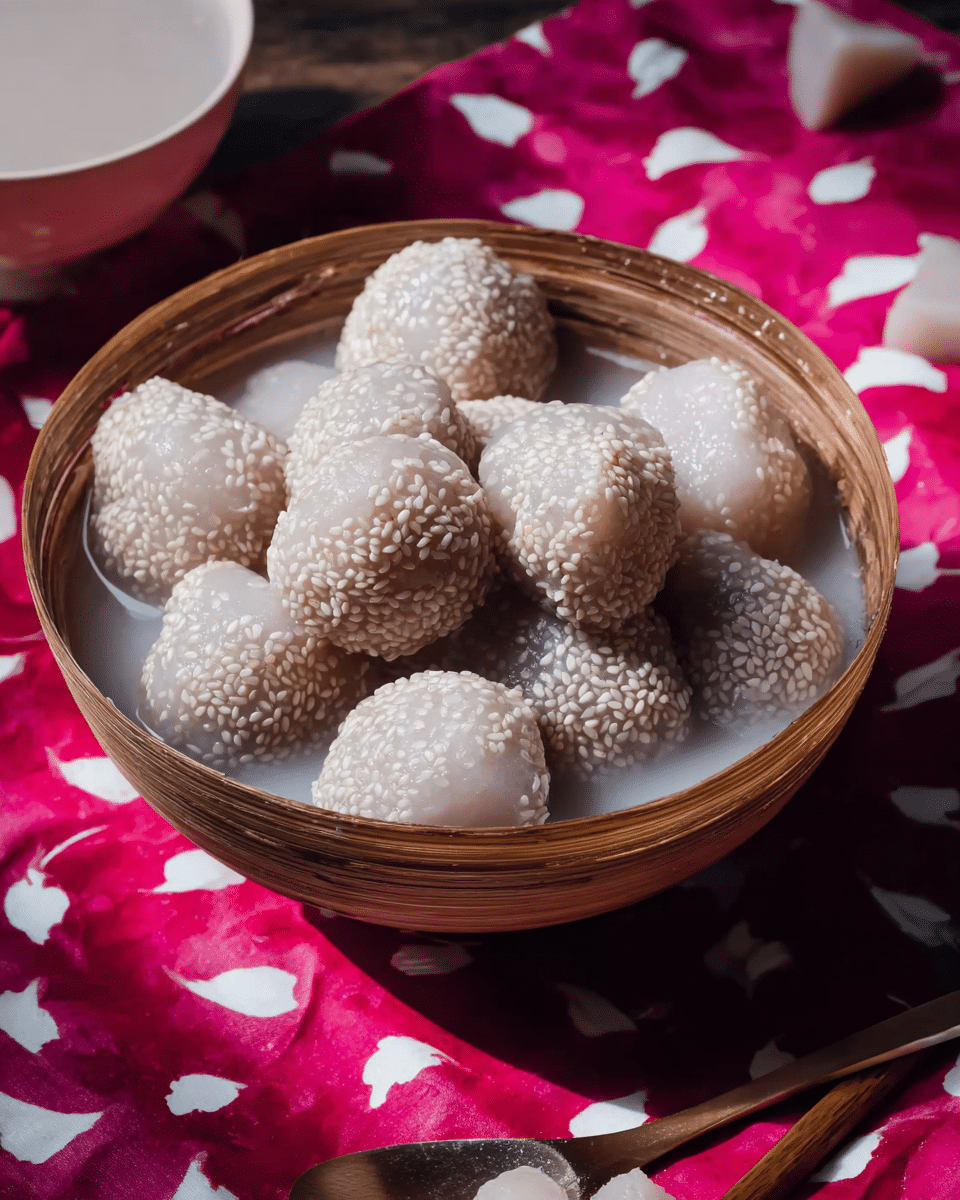These Sweet Taro Balls offer a delightful combination of crispy exteriors and a soft, chewy inside. The coating of sesame seeds adds a nutty crunch that perfectly complements the sweet, starchy taro filling.
Whether served as a snack or dessert, these bite-sized treats are sure to impress with their golden, crispy outer layer. They make a perfect addition to any party or celebration, offering a touch of sweetness that balances the savory flavors of the sesame seeds. Easy to prepare and utterly addictive, they’re a must-try for anyone craving a satisfying bite of something sweet and crispy.
Full recipe:
Ingredients:
-
500g taro, peeled and cut into chunks
-
50g glutinous rice flour
-
100g sugar
-
1/2 tsp salt
-
Water, as needed
-
1/2 cup sesame seeds
-
Vegetable oil for frying
Directions:
-
Steam the taro chunks for about 25 minutes or until tender.
-
Mash the cooked taro until smooth.
-
In a bowl, mix the mashed taro, glutinous rice flour, sugar, and salt. Add water a little at a time to form a smooth dough.
-
Divide the dough into small balls, about the size of a walnut.
-
Roll the taro balls in sesame seeds until fully coated.
-
Heat the oil in a deep pan over medium heat. Fry the taro balls in batches until golden brown and crispy, about 3-4 minutes per batch.
-
Remove the balls and drain them on paper towels to remove excess oil.
Prep Time: 20 minutes | Cooking Time: 30 minutes | Total Time: 50 minutes Kcal: 180 kcal | Servings: 6 servings
Origin and Tradition of Sweet Taro Balls
Sweet taro balls are deeply rooted in Chinese culinary traditions, particularly in Taiwanese culture. In Taiwan, they are often served in a warm, sweet soup, usually made from coconut milk, which enhances the natural flavor of the taro and gives it a luxurious, velvety finish. This dessert is often a staple during festivals, family gatherings, or as a special treat enjoyed during evening meals. While taro root is traditionally used, variations with different colored sweet potatoes are also common, giving the balls vivid yellow or purple shades depending on the type of root used.
Taro, a starchy root vegetable that resembles yam, is widely appreciated in Asian cuisine for its versatility. It can be used in savory dishes or transformed into sweet, decadent desserts. The natural color of taro adds a beautiful pop to any dish, and when paired with glutinous rice flour and tapioca flour, it creates a dough with a smooth yet chewy consistency, making it an ideal base for these delicious balls.
Preparing Sweet Taro Balls
The process of making sweet taro balls begins by steaming taro or sweet potato until tender. After steaming, the root is mashed into a dough-like consistency and combined with tapioca flour. The mixture is then shaped into small balls, coated in more tapioca flour, and boiled until they float to the surface of the water, a key indication that they are ready to be served.
The balls are typically cooked in boiling water for a brief time, followed by refreshing them in ice water. This cooling process helps to set the texture, ensuring the balls maintain their chewy and slightly elastic consistency. Afterward, they are rolled in sugar, and optionally, served with coconut syrup for added sweetness and richness. The syrup itself is a perfect balance of sugar and coconut cream, which enhances the natural flavors of the taro while providing a luxurious and creamy base.
Versatility of Taro Balls
While the classic taro balls are made with taro root, many people have adapted the recipe using different types of sweet potatoes. Sweet potatoes not only add a beautiful color to the dish but also provide a slightly different taste. Purple sweet potatoes give a rich, deep purple hue, while orange sweet potatoes create a vibrant golden ball. Both versions are equally delicious and can be enjoyed in a similar manner.
In addition to serving sweet taro balls in coconut syrup, they can be paired with a variety of other dessert bases. Some variations include placing them in a sweet red bean soup or serving them alongside crushed ice and a sprinkle of toasted sesame seeds. No matter the preparation method, sweet taro balls remain a crowd-pleaser, offering versatility that can easily be tailored to suit different preferences.
Sweet Taro Balls and Their Cultural Significance
Beyond their culinary appeal, sweet taro balls also hold cultural significance in various parts of Asia. In Taiwan, for instance, the dish is closely associated with the Mid-Autumn Festival, a time when families come together to celebrate harvests and reunite under the full moon. During this celebration, dishes like sweet taro balls are enjoyed with family and friends, symbolizing togetherness and prosperity.
In Hong Kong, these taro balls are often served during celebrations or as a traditional dessert. Their preparation and presentation may vary slightly, but the essence of the dish remains the same. They are a reminder of the deep-rooted food traditions that emphasize both family bonding and the enjoyment of quality, simple ingredients.
Health Benefits of Taro and Sweet Potato
Both taro and sweet potatoes are packed with nutrients that offer several health benefits. Taro is an excellent source of dietary fiber, potassium, and vitamins, particularly vitamin C and B6. It helps in digestion and supports cardiovascular health. Additionally, taro is a low-fat, gluten-free option, making it suitable for a variety of dietary needs.
Sweet potatoes, depending on the variety, are rich in antioxidants like beta-carotene and anthocyanins, which contribute to overall health. They are known for their ability to improve vision, support immune function, and maintain healthy skin. By incorporating these ingredients into the sweet taro balls, you’re not only treating yourself to a delicious dessert but also enjoying the nutritional benefits these roots have to offer.
Sweet Taro Balls as a Comforting Dessert
Sweet taro balls are the perfect comfort food. Whether you’re enjoying them as a snack on a chilly evening or serving them to guests at a special gathering, these little balls offer a sense of warmth and satisfaction. The chewy texture, combined with the richness of the coconut syrup, creates a dessert that feels indulgent yet light, making it an excellent choice for those who prefer a balanced, flavorful sweet treat.
For those who prefer a lighter version, you can skip the coconut syrup and enjoy the taro balls on their own or with a simple dusting of powdered sugar. This makes for a delightful, slightly less sweet version of the treat, still packing plenty of flavor and texture.
Conclusion: Why Sweet Taro Balls Should Be a Staple on Your Dessert Table
Sweet taro balls are not just a delicious dessert but also an experience that evokes the essence of Asian culinary tradition. The chewy texture, subtle sweetness, and adaptability to different variations make it a versatile choice for any occasion. From family dinners to festive celebrations, sweet taro balls bring people together and offer a taste of something truly special.
Whether you’re following the traditional recipe with coconut syrup or experimenting with your own flavor combinations, sweet taro balls offer endless possibilities. So, if you’re looking for a dessert that’s both comforting and exotic, look no further than these little delights. They’re sure to become a cherished addition to your dessert repertoire, offering a taste of Asian culinary heritage with every bite.






